Cone shaped mushrooms are a fascinating and diverse group of fungi that capture the imagination with their unique and striking appearance.
These mushrooms, also known as conical mushrooms, are characterized by their distinct cone-shaped caps which often taper to a pointed tip.
Found in various habitats across the globe, these mushrooms come in a wide array of colors, sizes, and textures, making them an intriguing subject for both mushroom enthusiasts and scientists alike.
The conical shape of these mushrooms is not only visually appealing but also serves important ecological functions.
Their distinctive cap shape helps to funnel rainwater towards the stem, protecting the delicate gills or pores underneath from becoming saturated. This adaptation allows cone shaped mushrooms to thrive in damp environments where other species might struggle.
List of Cone Shaped Mushrooms
1. Morels
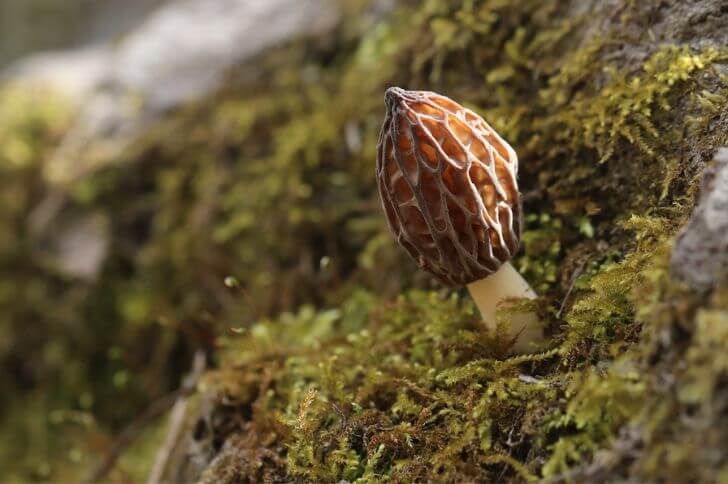
Morels are a type of edible mushroom that have a distinctive cone-shaped appearance. These mushrooms are highly sought after by foragers and gourmet chefs alike due to their unique flavor and meaty texture.
Morels can range in color from pale tan to dark brown, and their caps are covered in a network of ridges and pits.
One of the reasons why morels are so highly prized is because they have a rich, earthy flavor that is often described as nutty or smoky.
This makes them a popular ingredient in many dishes, such as soups, risottos, and pasta sauces. Morels also have a firm texture that holds up well during cooking, making them an ideal addition to sautés or stir-fries.
When preparing morels, it’s best to clean them gently with a soft brush or cloth.
2. Shaggy mane mushrooms

Shaggy mane mushrooms are cone-shaped fungi that belong to the family Agaricaceae. These mushrooms are commonly found in North America and Europe and are easily recognizable by their unique appearance.
The cap of the shaggy mane mushroom starts off oval-shaped but gradually elongates into a cylindrical shape as it matures. It is covered with white or brownish scales that give it a shaggy appearance.
One interesting characteristic of shaggy mane mushrooms is their ability to release spores through an intriguing process known as autodigestion or deliquescence.
As the mushroom ages, the gills beneath its cap dissolve into black ink-like liquid, which contains millions of spores ready to be dispersed by wind or raindrops. This process typically occurs within hours after the cap opens up fully, making it an incredibly rapid transformation.
Apart from their distinctive appearance and fascinating life cycle, shaggy mane mushrooms have long been used in culinary practices for their flavor and texture.
When young and firm, these canonical mushrooms can be consumed raw in salads or cooked in various dishes such as soups, stir-fries, omelets, or sautés.
3. Conocybe Apala (White Dunce Cap)
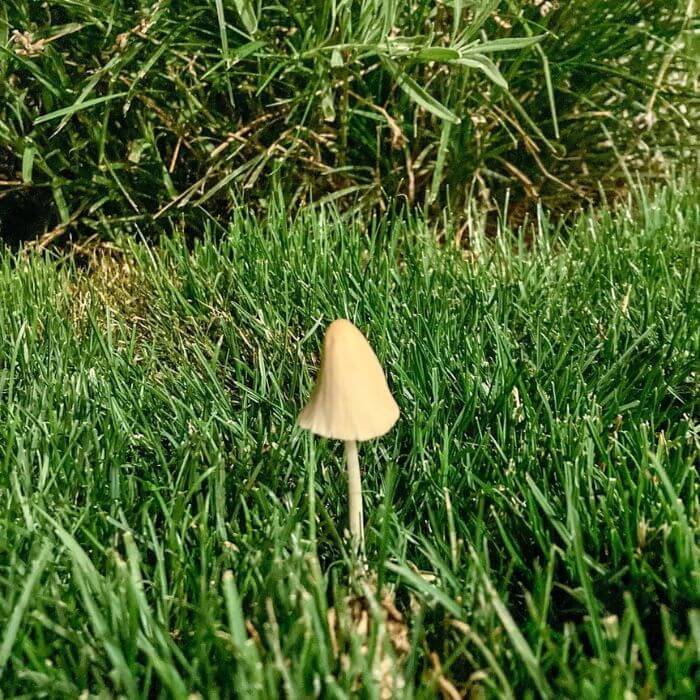
source:scifiwasabiofficial
Conocybe apala is a species of fungus that belongs to the family Bolbitiaceae. This small mushroom typically has a conical or bell-shaped cap that can reach about 1.18 inches in diameter.
The color of its cap varies from yellowish-brown to light brown, while the stem is usually slender and fragile.
One distinct characteristic of Conocybe apala is its spore print, which appears brownish or rusty-brown in color.
Additionally, this mushroom has gills that are attached to the stem and are initially white but darken with age. These mushrooms are often found growing in grassy areas, lawns, or even on decomposing wood.
4. Mycena Polygramma (Grooved Bonnet)
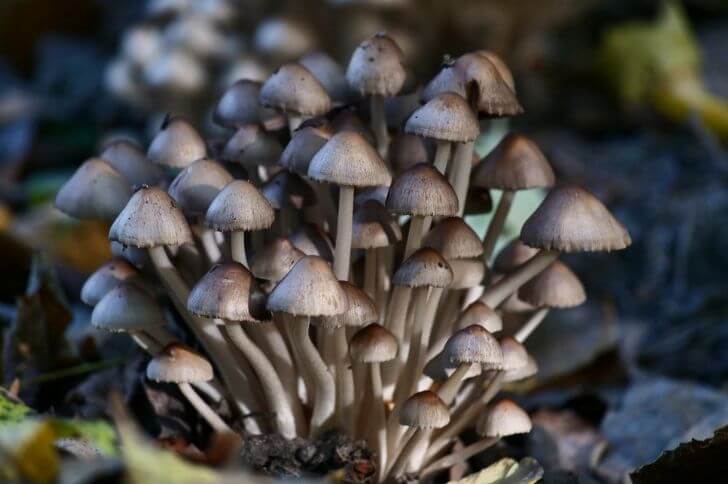
Mycena polygramma is a fascinating species of fungi that belongs to the Mycenaceae family. These petite mushrooms typically have a cone-shaped cap and can be found in various habitats, including deciduous forests and grasslands.
The cap of M. polygramma ranges in color from pale grayish-green to olive-brown, with a smooth surface that often appears moist or slimy when wet.
One distinctive feature of M. polygramma is its gills, which are widely spaced and attached to the stem. These gills start off white but darken as they mature, eventually turning blackish-brown in color.
The stem of this mushroom is slender and fragile, often measuring around 2.4-5.9 inches in length. It is typically grayish in color.
Despite its small size and delicate appearance, Mycena polygramma plays an essential role in the ecosystem as it decomposes organic matter on forest floors.
It primarily feeds on decaying plant material such as fallen leaves and woody debris, aiding in nutrient recycling within its habitat. This fungus also forms symbiotic relationships with trees by establishing mycorrhizal associations – mutually beneficial partnerships where it exchanges nutrients with tree roots.
5. Entoloma Quadratum
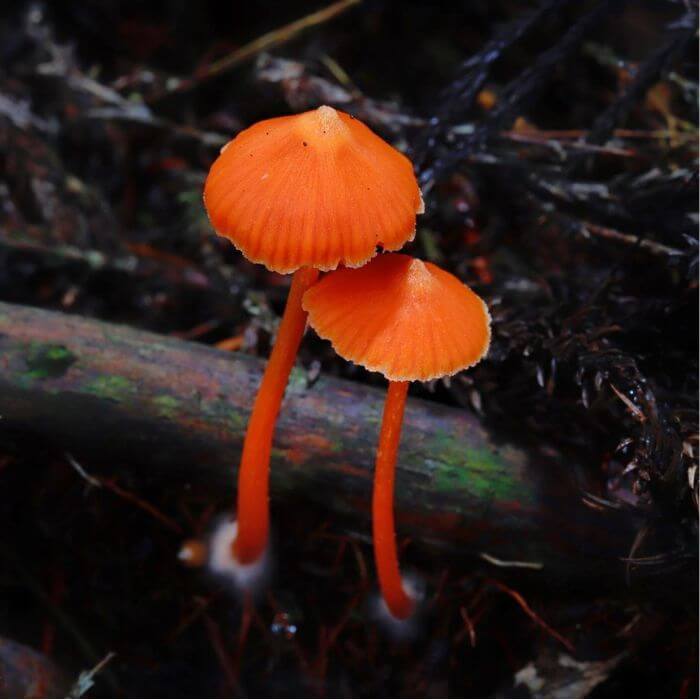
source:fungi_in_the_woods
Another type of canonical mushroom you should know about is the entoloma quadratum. These cone-shaped mushrooms have a distinctive appearance, with a bell-shaped cap that tapers towards the base.
The cap can measure anywhere from 1 to 2 inches in diameter and ranges in color from salmon orange to yellow. It is smooth on the surface.
One notable characteristic of Entoloma quadratum is its gills, which are widely spaced and adnate (attached) to the stem. They start off pale but gradually turn brownish as they mature.
The stem itself is usually slender and cylindrical, measuring around 1.5-3.9 inches in length and 2mm thickness.
These mushrooms typically grow in clusters on decaying wood or soil rich in organic matter, such as forest floors or grasslands.
While it is considered non-toxic, Entoloma quadratum is generally not recommended for consumption due to its bitter taste.
6. Phaeocollybia Christinae (Christina’s rootshank)
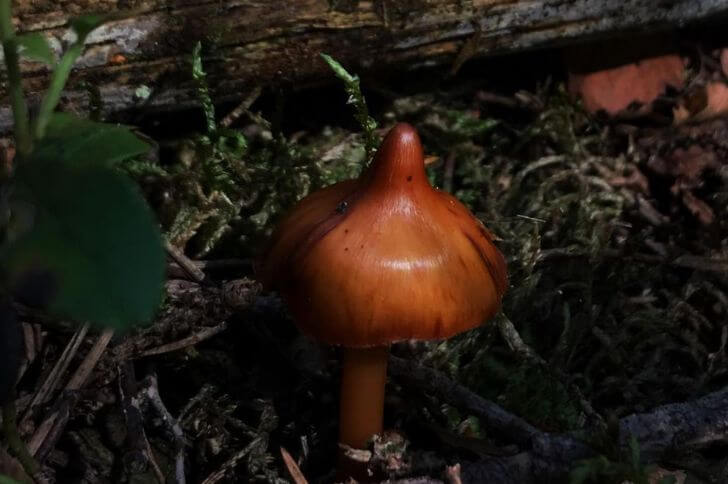
source: soppverden
Phaeocollybia christinae is a species of cone-shaped mushroom that belongs to the family Cortinariaceae. It is commonly found in North America, particularly in coniferous forests.
This small to medium-sized mushroom has a distinctive appearance with a cone-shaped cap and a slender stem. The cap can vary in color from pale brown to dark reddish-brown.
The spore-bearing surface of Phaeocollybia christinae, called the hymenium, is located on the underside of the cap. It consists of closely spaced gills that are typically reddish-yellow.
The stem of this mushroom is usually smooth and cylindrical, sometimes slightly thicker at the base.
Although Phaeocollybia christinae may not be as well-known as some other mushroom species, its unique cone shape and variations in color make it an interesting find for mushroom enthusiasts and nature lovers alike.
7. Inocybe Subcarpta
Inocybe subcarpta is a species of mushroom belonging to the Inocybe genus. These mushrooms are characterized by their distinctive canonical caps, often with pointed tips, which can range in color from pale beige to dark brown.
The caps typically measure around 1-3 inches in diameter and have a smooth or slightly wrinkled surface.
One notable feature of Inocybe subcarpta is its gills. These gills are closely spaced. The gills themselves are usually white initially but turn grayish-brown as spores develop.
Found predominantly in North America and Europe, Inocybe subcarpta is commonly associated with deciduous forests and can often be found growing on leaf litter or mossy ground.
8. Mycena amabilissima
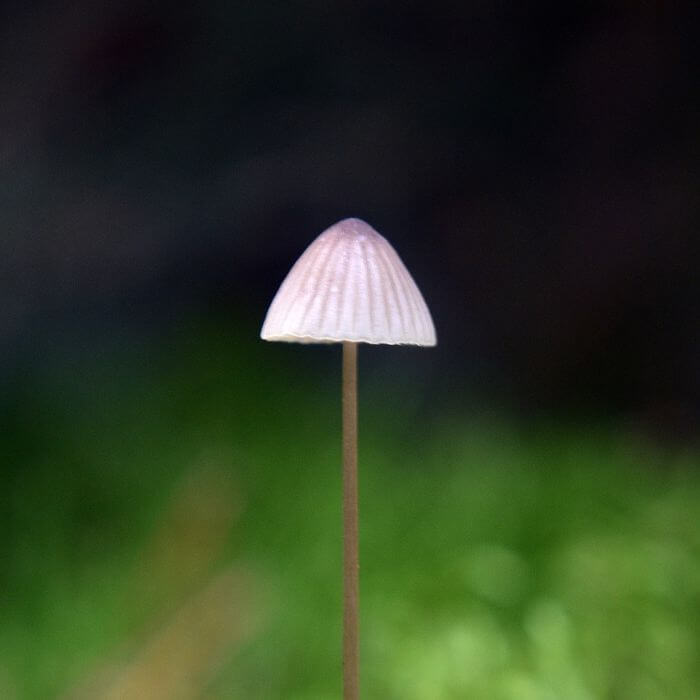
Mycena amabilissima is a species of mushroom that belongs to the Mycena genus. These cone-shaped mushrooms are known for their delicate and charming appearance.
With caps measuring around 1-2 inches in diameter, these petite mushrooms showcase a vibrant range of colors. Their caps can vary from pink to yellowish pink.
This colorful display is often accompanied by a translucent surface that adds an ethereal touch to these already elegant mushrooms.
In addition to their eye-catching appearance, Mycena amabilissima also possesses other notable characteristics. The stem of this mushroom species tends to be slender and fragile, typically growing up to 6 inches tall.
When young, it boasts a whitish color but gradually becomes translucent or slightly yellow as it matures. Furthermore, Mycena amabilissima often thrives in damp woodland areas where it forms fairy rings or small clusters on decaying wood or leaf litter.
While not commonly used for culinary purposes due to their size and fragility, these enchanting mushrooms are highly sought-after by photographers and nature enthusiasts who appreciate their delicate beauty and unique presence in the natural world.
9. Parasola auricoma
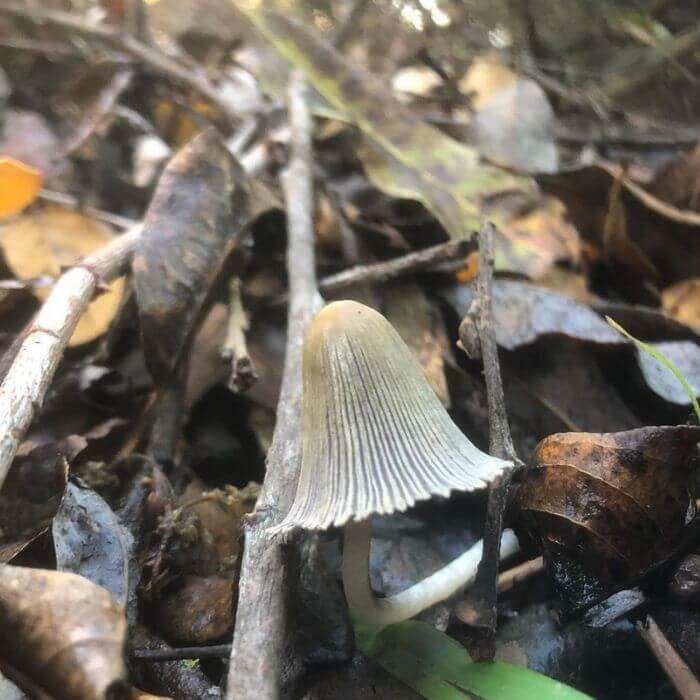
Parasola auricoma that belongs to the family Psathyrellaceae. This fungus is characterized by its slender and tall stem, which can grow up to 4.7 inches in height. The cap of parasola auricoma is cone-shaped when young but gradually flattens out with age, reaching a diameter of around 2.3 inches.
One distinguishing feature is the olive-brown coloration on both the cap and stem, while the gills underneath are pale grayish-brown in hue.
These mushrooms typically grow in grassy areas or in wood chips during spring and autumn seasons. Despite their small size, they can form dense clusters that create an aesthetic appeal when observed from afar.
In terms of edibility, parasola auricoma is not recommended for consumption due to its bitter taste. However, it plays an important ecological role as it decomposes organic matter on forest floors or grasslands. Additionally, these mushrooms serve as a food source for various insects and small animals in their habitats.
10. Phallus impudicus (Common Stinkhorn)
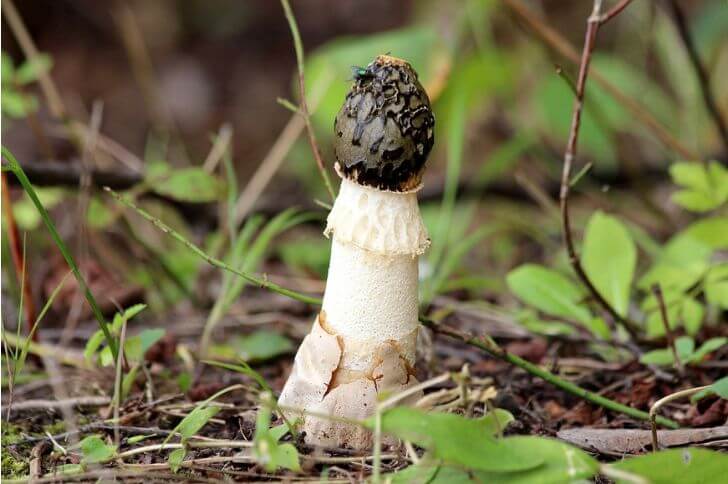
Phallus impudicus is a fascinating and peculiar species found in various parts of the world. These cone-shaped mushrooms are notorious for their distinctive foul odor that resembles rotting meat or sewage.
The smell serves a crucial purpose in attracting flies and other insects, which play a vital role in the mushroom’s reproductive process. As these insects land on the mushroom to feed on its sticky spore mass, they unknowingly become carriers of its spores, allowing them to disperse and potentially grow new fungi elsewhere.
While this canonical mushroom may not be visually appealing to everyone due to its rather unappealing appearance and unpleasant smell, it plays an essential role within ecosystems.
This unique fungus often emerges from leaf litter or decaying wood, breaking down organic matter and aiding in nutrient recycling.
Final Thoughts:
In conclusion, cone-shaped mushrooms are fascinating. Their distinctive shape and vibrant colors make them stand out in any natural setting.
While they may not be as well-known as other types of mushrooms, their ecological significance cannot be understated.
Additionally, their spores serve as a crucial component of fungal reproduction and dispersion. As nature lovers and enthusiasts, let us continue to appreciate and learn about the diverse wonders of the natural world, including these remarkable mushrooms with canonical caps.
So next time you are out exploring, keep an eye out for these magnificent fungi and take a moment to marvel at their beauty and importance.
Sources:
Hi There,
My name is Jenny. I’m the Chief Editor at Try Green Recipes and besides making yummy and healthy foods for my kids, grandkids, and friends. I’m new to the blogging world but I believe what I have to share is unique and will bring joy to your home. If you are adventurous and want try something tasty, let’s get started.

